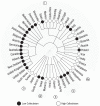From Text to Thought: How Analyzing Language Can Advance Psychological Science
- PMID: 34606730
- PMCID: PMC9069665
- DOI: 10.1177/17456916211004899
From Text to Thought: How Analyzing Language Can Advance Psychological Science
Abstract
Humans have been using language for millennia but have only just begun to scratch the surface of what natural language can reveal about the mind. Here we propose that language offers a unique window into psychology. After briefly summarizing the legacy of language analyses in psychological science, we show how methodological advances have made these analyses more feasible and insightful than ever before. In particular, we describe how two forms of language analysis-natural-language processing and comparative linguistics-are contributing to how we understand topics as diverse as emotion, creativity, and religion and overcoming obstacles related to statistical power and culturally diverse samples. We summarize resources for learning both of these methods and highlight the best way to combine language analysis with more traditional psychological paradigms. Applying language analysis to large-scale and cross-cultural datasets promises to provide major breakthroughs in psychological science.
Keywords: comparative linguistics; creativity; cultural evolution; emotion; historical linguistics; natural-language processing; psycholinguistics; religion.
Conflict of interest statement
Figures





References
-
- Allport G. W., Vernon P. E. (1930). The field of personality. Psychological Bulletin, 27(10), 677–730.
-
- Althoff T., Danescu-Niculescu-Mizil C., Jurafsky D. (2014). How to ask for a favor: A case study on the success of altruistic requests. arXiv. https://arxiv.org/abs/1405.3282
-
- American Psychiatric Association. (2013). Diagnostic and statistical manual of mental disorders (5th ed.). 10.1176/appi.books.978089042559 - DOI
Publication types
MeSH terms
Grants and funding
LinkOut - more resources
Full Text Sources

